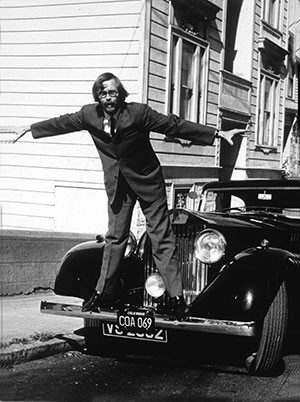Born 1933, McPherson, Kansas
Died 2008, San Francisco, California
In 1957 Bruce Conner dropped out of the MFA program at the University of Colorado in Boulder and moved to San Francisco. Arriving at the height of the Beat movement, he joined the experimental, underground artistic community that was flourishing in the absence of a viable art market. Conner, however, also maintained a high profile in New York, where he was already represented by the uptown Alan Gallery. He earned a national reputation with his shocking sculpture CHILD (1959), a grotesque wax figure lashed to a high chair with nylon stockings.
In addition to the films he made, Conner is best known for his pioneering assemblages, which he called “Rat Bastards.” Between 1957 and 1964 he made nearly two hundred of these hybrid accretions of found objects bound together with nylons. For materials Conner raided junk shops and run-down Victorian houses in Western Addition, a predominantly African American neighborhood. Using scavenged objects and adopting a self-consciously marginalized stance, he created sculptures inspired by installations made by local junk dealers and other storeowners. In 1961 MoMA crystallized this emergent art form in its Art of Assemblage exhibition, catapulting Conner to the forefront of an international trend. He had encouraged the show’s curator, William Seitz, to include vernacular examples, taking him on a tour of Bay Area storefronts. Though Seitz declined this suggestion, he did cite the Watts Towers in Los Angeles and gestured to affinities with “primitive and folk artists” in the exhibition catalog.
Conner frequently embraced visionary, mystical, and religious motifs in his narrative creations. A talismanic collection of trinkets and sundry materials encased in a gauzy sheath, his pendulous RAT PURSE draws on the form of the voodoo “mojo” bag. In CRUCIFIXION, a dismembered figure, seemingly burnt and buried under cobwebs of nylon, is an abject reimagining of the traditional religious subject. SEÑORITA derives from Conner’s brief stay in Mexico City, where makeshift altars and local materials shaped the construction of his assemblages.
In 1968, anxious to evade easy classification, Conner gave up his New York representation and turned increasingly to performance and conceptual art. Working fluidly in a range of media and later associating with the hippie and punk subcultures, he remained a restless maverick.
Jenevive Nykolak
Frieling, Rudolf, and Gary Garrels, eds. Bruce Conner: It’s All True. With Stuart Comer et al. San Francisco: San Francisco Museum of Modern Art, with University of California Press, 2016.
Hatch, Kevin. Looking for Bruce Conner. Cambridge: MIT Press, 2012.
